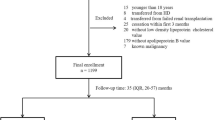Abstract
Disturbances in the metabolism of lipoprotein profiles and oxidative stress in hemodialyzed (HD) and post-renal transplant (Tx) patients are proatherogenic, but elevated concentrations of plasma high-density lipoprotein (HDL) reduce the risk of cardiovascular disease. We investigated the concentrations of lipid, lipoprotein, HDL particle, oxidized low-density lipoprotein (ox-LDL) and anti-ox-LDL, and paraoxonase-1 (PON-1) activity in HD (n=33) and Tx (n=71) patients who were non-smokers without active inflammatory disease, liver disease, diabetes, or malignancy. HD patients had moderate hypertriglyceridemia, normocholesterolemia, low HDL-C, apolipoprotein A-I (apoA-I) and HDL particle concentrations as well as PON-1 activity, and increased ox-LDL and anti-ox-LDL levels. Tx patients had hypertriglyceridemia, hypercholesterolemia, moderately decreased HDL-C and HDL particle concentrations and PON-1 activity, and moderately increased ox-LDL and anti-ox-LDL levels as compared to the reference, but ox-LDL and anti-ox-LDL levels and PON-1 activity were more disturbed in HD patients. However, in both patient groups, lipid and lipoprotein ratios (total cholesterol (TC)/HDL-C, LDL-C/HDL-C, triglyceride (TG)/HDL-C, HDL-C/non-HDL-C, apoA-I/apoB, HDL-C/apoA-I, TG/HDL) were atherogenic. The Spearman’s rank coefficient test showed that the concentration of ox-LDL correlated positively with HDL particle level (R=0.363, P=0.004), and negatively with TC (R=−0.306, P=0.012), LDL-C (R=−0.283, P=0.020), and non-HDL-C (R=−0.263, P=0.030) levels in Tx patients. Multiple stepwise forward regression analysis in Tx patients demonstrated that ox-LDL concentration, as an independent variable, was associated significantly positively with HDL particle level. The results indicated that ox-LDL and decreased PON-1 activity in Tx patients may give rise to more mildly-oxidized HDLs, which are less stable, easily undergo metabolic remodeling, generate a greater number of smaller pre-β-HDL particles, and thus accelerate reverse cholesterol transport, which may be beneficial for Tx patients. Further studies are necessary to confirm this.
Similar content being viewed by others
References
An, W.S., Kim, S.E., Kim, K.H., Bae, H.R., Rha, S.H., 2009. Association between oxidized LDL to LDL ratio, HDL and vascular calcification in the feet of hemodialysis patients. J. Korean Med. Sci., 24 (Suppl. 1):S115–S120. [doi:10.3346/jkms.2009.24.S1.S115]
Chen, J.X., Zhou, J.F., Shen, H.C., 2005. Oxidative stress and damage induced by abnormal free radical reactions and IgA nephropathy. J. Zhejiang Univ. Sci. B, 6(1):61–68. [doi:10.1631/jzus.2005.B0061]
Cofan, F., Cofan, M., Campos, B., Guerra, R., Campistol, J.M., Oppenheimer, F., 2005. Effect of calcineurin inhibitors on low-density lipoprotein oxidation. Transplant. Proc., 37(9):3791–3793. [doi:10.1016/j.transproceed.2005.10.068]
Draganov, D., Teiber, J.F., Speelman, A., 2005. Human paraoxonases (PON1, PON2, and PON3) are lactonases with overlapping and distinct substrate specificities. J. Lipid Res., 46(6):1239–1247. [doi:10.1194/jlr.M400511-JLR200]
Furlong, C.E., Richter, R.J., Seidel, S.L., Costa, L.G., Motulsky, A.G., 1989. Spectrophotometric assays for the enzymatic hydrolysis of the active metabolities of chlorpyrifos and parathion by plasma paraoxonase/arylesterase. Anal. Biochem., 180(2):242–247. [doi:10.1016/0003-2697 (89)90424-7]
Gao, X., Jayaraman, S., Gursky, O., 2008. Mild oxidation promotes and advanced oxidation impairs remodeling of human high-density lipoprotein in vitro. J. Mol. Biol., 376(4):997–1007. [doi:10.1016/j.jmb.2007.12.030]
Guha, M., Gao, X., Jayaraman, S., Gursky, O., 2008. Correlation of structural stability with functional remodeling of high-density lipoproteins: the importance of being disordered. Biochemistry, 47(44):11393–11397. [doi:10.1021/bi8014746]
Joy, T., Hegele, R.A., 2008. Is raising HDL a futile strategy for atheroprotection? Nat. Rev. Drug Discov., 7(2):143–155. [doi:10.1038/nrd2489]
Kimak, E., Solski, J., Baranowicz-Gąszczyk, I., Książek, A., 2008. Serum lipid, leptin, parameters of oxidative stress and PON-1 activity in post-renal transplant patients. Ann. UMCS Pharm., 21(1):355–360. [doi:10.2478/v10080-008-0067-0]
Kimak, E., Hałabiś, M., Baranowicz-Gąszczyk, I., 2010. Relationships between serum lipid, lipoprotein, triglyceriderich lipoprotein, and high-density lipoprotein particle concentrations in post-renal transplant patients. J. Zhejiang Univ.-Sci. B (Biomed. & Biotechnol.), 11(4):249–257. [doi:10.1631/jzus.B1000012]
Krishnaswamy, P.R., Rao, A., Murali, W., Ballal, S., 2006. Paraoxonase activity to oxidized-LDL in chronic renal failure patients on renal replacement therapy. Indian J. Clin. Biochem., 21(2):173–176. [doi:10.1007/BF02912937]
Moradi, H., Pahl, M.V., Elahimehr, R., Vaziri, N.D., 2009. Impaired antioxidant activity of high-density lipoprotein in chronic kidney disease. Transl. Res., 153(2):77–85. [doi:10.1016/j.trsl.2008.11.007]
Moreno, J.M., Ruiz, M.C., Ruiz, N., Gomez, I., Vargaz, F., Asensio, C., Osuna, A., 2005. Modulation factors of oxidative status in stable renal transplantation. Transplant. Proc., 37(3):1428–1430. [doi:10.1016/j.transproceed.2005.02.037]
Pirillo, A., Uboldi, P., Pappalardo, G., Kuhn, H., Catapano, A.L., 2007. Modification of HDL3 by mild oxidative stress increases ATP-binding cassette transporter 1-mediated cholesterol efflux. Cardiovas. Res., 75(3): 566–574. [doi:10.1016/j.cardiores.2007.04.021]
Prakash, M., Phani, N.M., Kavya, R., Supriya, M., 2010. Paraoxonase: its antiatherogenic role in chronic renal failure. Indian J. Nephrol., 20(1):9–14. [doi:10.4103/0971-4065.62088]
Rizzo, M., Kotur-Stevuljevic, J., Berneis, K., Spinas, G., Rini, G.B., Jelic-Ivanovic, Z., Spasojevic-Kalimanovska, V., Vekic, J., 2009. Atherogenic dyslipidemia and oxidative stress: a new look. Transl. Res., 153(5):217–223. [doi:10.1016/j.trsl.2009.01.008]
Sakuma, N., Saeki, T., Ito, T., Hibino, T., Suzuki, S., Kunimatsu, M., Yamamoto, K., Kitada, S., 2010. HDL2 can inhibit further oxidative modification of partially oxidized LDL. J. Atheroscler. Thromb., 17(3):229–234.
Samouilidou, E., Karpouza, A., Grapsa, E., Tzanatou-Exarchou, H., 2010. Serum oxidized LDL is inversely associated with HDL2-cholesterol subclass in renal failure patients on hemodialysis. Nephron Clin. Pract., 115(4): 289–294. [doi:10.1159/000313488]
Shuhei, N., Söderlund, S., Jauhiainen, M., Taskinen, M.R., 2010. Effect of HDL composition and particle size on the resistance of HDL to the oxidation. Lipids Health Dis., 9(1):104–114. [doi:10.1186/1476-511X-9-104]
Stanisz, A., 2000. Approachable Statistical Course Based on STATISTICA PL Program on Medical Examples. Vol. II, Krakow, Poland, p.129–158 (in Polish).
Sviridov, D., Mukhamedova, N., Remaley, A.T., Chin-Dusting, J., Nestel, P., 2008. Antiatherogenic functionality of high density lipoprotein: how much versus how good. J. Atheroscler. Thromb., 15(2):52–62.
Author information
Authors and Affiliations
Corresponding author
Additional information
Project (Nos. PW 55/09 and DS 41/10) supported by the Department of Laboratory Diagnostics, Medical University of Lublin, Poland
Rights and permissions
About this article
Cite this article
Kimak, E., Hałabiś, M., Baranowicz-Gąszczyk, I. et al. Association between moderately oxidized low-density lipoprotein and high-density lipoprotein particle subclass distribution in hemodialyzed and post-renal transplant patients. J. Zhejiang Univ. Sci. B 12, 365–371 (2011). https://doi.org/10.1631/jzus.B1000348
Received:
Accepted:
Published:
Issue Date:
DOI: https://doi.org/10.1631/jzus.B1000348
Key words
- Lipids
- Lipoproteins
- Paraoxonase-1 (PON-1) activity
- Oxidized low-density lipoprotein (ox-LDL)
- High-density lipoprotein (HDL) particles
- Post-renal transplant
- Hemodialysis




